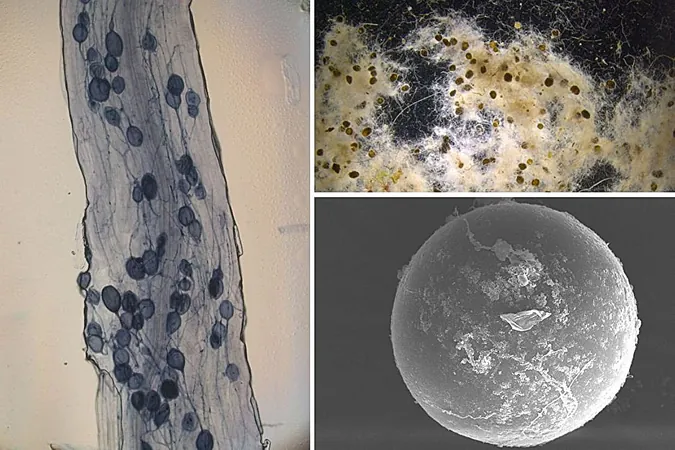
Unlocking Nature's Secrets: How Mycorrhizal Fungi Transform Agriculture by Teaming Up with Soil Bacteria
2025-04-16
Author: Charlotte
A Timeless Partnership: Plants and Mycorrhizal Fungi
For eons, plants and arbuscular mycorrhizal fungi have thrived together in a remarkable bond of mutual benefit. These fungi attach to plant roots, playing a crucial role in nutrient absorption while receiving carbon in return. As Mohamed Hijri, a leading professor at Université de Montréal, explains, "These biotrophic fungi can't achieve their nutritional needs alone. Instead, they form an essential symbiosis, or mycorrhiza, with plant roots."
The Underground Network: Nature’s Nutrient Highway
While many plants can survive without these fungi, the extensive web of white filaments known as extraradical mycelium beneath our feet significantly boosts water and nutrient uptake. According to Ph.D. candidate Zakaria Lahrach, "These fungi serve as an extension of roots, helping plants explore the soil for vital nutrients more effectively."
A New Discovery: Fungi, Bacteria, and the Soil Ecosystem
As researchers delve into this fascinating plant-fungal partnership, they’ve begun to uncover the intricate relationships fungi maintain with bacterial communities in the soil. Astonishingly, the fungi release some of the carbon they absorb back into the soil, attracting bacteria that break down organic matter, ultimately releasing nutrients for plant use. This ability also contributes to carbon sequestration, which is pivotal in the fight against climate change.
Exploring the Mechanisms: Lahrach’s Pioneering Research
In his Ph.D. thesis, Lahrach set out to investigate how arbuscular mycorrhizal fungi attract soil bacteria and enhance phosphate availability—essential for plant growth. After two years of rigorous experimentation, his groundbreaking findings were published in the journal Environmental Microbiome.
Testing Three Fungal Warriors
Lahrach focused on the bacterial recruitment capabilities of three fungal species: Rhizophagus irregularis, Rhizophagus clarus, and Rhizophagus cerebriforme. He explored whether introducing non-native bacteria could influence the fungi's recruitment efforts. Lahrach commented, "We aimed to discern the unique contributions of plants and fungi to bacterial recruitment.”
A Unique Ecosystem: Evolution in Action
The research demonstrated that all three fungal species significantly promoted the growth of experimental plants, like leeks, as indicated by improved biomass and chlorophyll levels. Although closely genetically related, each fungus fostered distinct bacterial communities tailored to the experimental conditions. Notably, microbial bioaugmentation proved effective only alongside the fungi, showcasing their vital role as facilitators in this ecosystem.
Fungi: The Nutrient Conductors of Agriculture
These mycorrhizal fungi act as a bridge between the soil's microbiota and plant roots, efficiently modulating interactions that allow for nutrient absorption. "They are like a transmission belt between the soil and the roots," Hijri emphasizes.
A Green Solution for Modern Agriculture
As global agriculture faces immense challenges, leveraging mycorrhizal fungi could significantly enhance soil health, reducing the reliance on chemical fertilizers and pesticides. This study reveals the complex, beneficial interactions between these fungi and soil bacteria, opening doors for sustainable agricultural practices.
The Bottom Line: Healthy Soil Equals Fertile Land
Hijri concludes, "Mycorrhizal fungi are an indispensable part of the soil microbiome, playing a crucial role in maintaining soil health. And healthy soil? That’s the foundation of sustainable, fertile land for the future."









 Brasil (PT)
Brasil (PT)
 Canada (EN)
Canada (EN)
 Chile (ES)
Chile (ES)
 Česko (CS)
Česko (CS)
 대한민국 (KO)
대한민국 (KO)
 España (ES)
España (ES)
 France (FR)
France (FR)
 Hong Kong (EN)
Hong Kong (EN)
 Italia (IT)
Italia (IT)
 日本 (JA)
日本 (JA)
 Magyarország (HU)
Magyarország (HU)
 Norge (NO)
Norge (NO)
 Polska (PL)
Polska (PL)
 Schweiz (DE)
Schweiz (DE)
 Singapore (EN)
Singapore (EN)
 Sverige (SV)
Sverige (SV)
 Suomi (FI)
Suomi (FI)
 Türkiye (TR)
Türkiye (TR)
 الإمارات العربية المتحدة (AR)
الإمارات العربية المتحدة (AR)